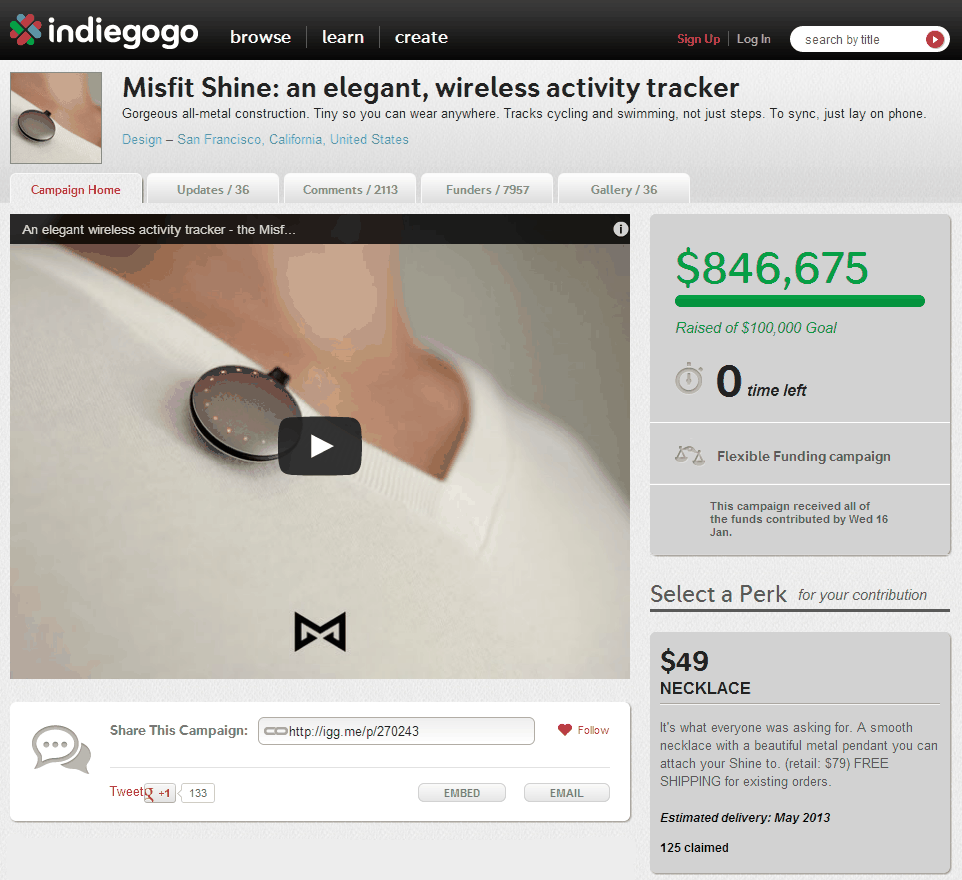(Editor’s Note: Dan Munro writes for Forbes.com under the heading, HealthCare Compass)
(Editor’s Note: Dan Munro writes for Forbes.com under the heading, HealthCare Compass)
This isn’t the first time that a consumer health and wellness device has rocked the Indiegogo world. I wrote about Misfit Wearables “Shine” last year (here) and they quickly became the benchmark of success on the crowdfunding platform called Indiegogo. In fairness, the Shine didn’t register as a “health” campaign – but as a “design” campaign under the general heading of “Creative.” As a platform, Indiegogo has 24 different categories under 3 general headings: Entrepreneurial, Cause and Creative.
By the time the Misfit campaign to raise $100,000 closed (earlier this year) they had raised $846,675.
Crowdfunding campaigns don’t always succeed but the financial goal isn’t the only benchmark of success – or funding. At the earliest stages of a companies evolution, a loyal (and big) fan base is often a better strategic objective. The type of campaign (unrelated to category) is the determining factor for the dollars pledged, so understanding that distinction is an important element to any personal financial commitment (or “purchase”).
That’s not to say there isn’t risk. The campaign’s are often high on marketing collateral (glamorous pictures and slick videos) which have all the appearance of a retail product. Most of the time, the device or products (like Misfit’s Shine and Scanadu’s Scout) are engineering prototypes. As one VC suggested – there’s a significant difference between funding a project or single product and funding a company. In the case of both Misfit’s Shine and Scanadu’s Scout, the object isn’t as much about raising money as it is finding early (and hopefully loyal) adopters – at scale.
The more common challenge for projects that do get funded is missed deadlines – often around product manufacturing or delivery. The Pebble Watch (a project on Kickstarter last year that started with a goal of $100,000 and raised over $10 million) is a good case in point. At first, the creators of Pebble told supporters that the watch would be available in about 4 months – but shortly after the campaign ended they found it physically impossible to ship 85,000 pre-ordered watches on time so they announced an indefinite delay.
Noted angel investor and entrepreneur Francine Hardaway finally got her Pebble watch last month. Her online review was brief (here) and less than encouraging:
“I got my Pebble Watch today. What an anti-climax. Like the Basis, it’s too ugly for a woman to wear, even in red.” Francine Hardaway
Missed deadlines are actually the norm – not the exception. One study by CNN Money (here) found that 84% of Kickstarter projects ship late. Late last month, Misfit also announced a delay in their first shipment of their Shine (until mid-July) and that the Android version wouldn’t ship “at launch” as originally stated (Misfit Shine Drops Android Support, Delays Shipping Until July).
Which highlights the risk of all crowdfunding projects. The projects are raw – often by inexperienced teams – with ambitious ideas and limited skills navigating the treacherous waters of new product development, global manufacturing and delivery. In the case of healthcare, crowdfunding is also an easy way to bypass all of the traditional ways of vetting a clinical device for consumer use – including claims of clinical efficacy, FDA approval and/or just plain value. Most of the initial functions of the Scanadu Scout are readily available as individual consumer devices (many with FDA approval) on a drugstore shelf near you.
It’s also a way to completely navigate around the byzantine rules of reimbursement. This process has become so deadly that many startups simply say why bother – we’ll go direct-to-consumer. For a relatively simple product in the sub $200 range – it’s an easy and attractive option.
The way Kickstarter’s Co-Founder prefers to market the platform is less around an actual product pre-order – and more around the journey of creating a whole new product. That’s perfectly ok except that the prototypes are often marketed with all the advertising zeal and glamour of a finished product simply waiting for a large enough order to mass-produce. They aren’t.
Within the health category, Indiegogo is really the only platform available with virtually no campaign restrictions. Kickstarter actively vets and selects campaigns based on their own criteria and internal review. Even Apple AAPL +3.22% has started to restrict apps that require a medication dosing calculation (here). For that reason, Indiegogo has enjoyed significant success in the challenging health and wellness category. Some of the Indiegogo health and wellness projects to date include:
* Amiigo Fitness Bracelet (Goal: $100,000 – Raised: $580,698)
* Breathometer (Goal: $25,000 – Raised: $138,377)
* uBiome (Goal: $100,000 – Raised: $350,858)
* DrinkSavvy (Goal: $50,000 – Raised: $52,000)
* Breezing (Goal: $100,000 – Raised: $41,060)
Lightning seems to have struck again earlier this week when Scanadu’s Scout easily rocketed past $1M. Unlike other campaigns, however, Scanadu has elected to extend their original deadline by another 30 days. When the dollars are still rolling in – why stop? Scanadu’s product – called Scout – is aimed squarely at the consumer health market. From their Indiegogo campaign website:
Scanadu Scout™ is designed to be a medical grade Tricorder using your smartphone and Bluetooth LE to emulate an Emergency Room in your pocket.
That’s definitely an ambitious claim and the Scout is now (officially) the ”fastest funded” campaign in the history of Indiegogo. The timeline for shipping the Scout? March, 2014. That certainly sounds like a reasonable timeline based on the feature list and prototype today – but it’s a lifetime in the extremely fast moving world of health sensor technology and activity trackers. Still, a cool $1M+ (and counting) is clear indication of a loyal fan based of engaged users. That often makes big retailers – especially ones with a big pharmacy footprint – take notice.
